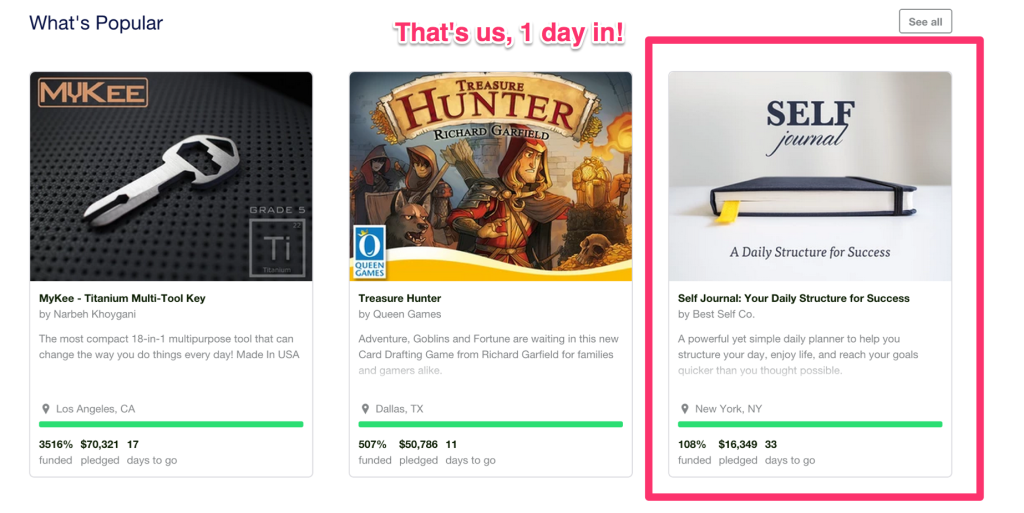
Over the past 2 years, I have run 3 Successful Kickstarter campaigns, each with increasing success as I’ve picked up tricks and skills along the way. I’ve learned some valuable and expensive lessons along the way. Here are the 7 big ones:
1. Don’t Underestimate Shipping
While running Calm The Ham, I’ve shipped prints all over the world to over 50 countries. When customers repeatedly asked me to include a frame option, it seemed like the next logical step. However, I was thinking quite illogically when it came to international shipping and Kickstarter. In my first Kickstarter project, The Filmography of Aircraft, I drastically underpriced the framed print rewards. Not only was the amount of time and labor more than I imagined but so too were the packing supplies and the actual shipment cost. I didn’t realize that once you went above a certain size (the prints were big at 24“ x 36”), you had to upgrade to a higher-priced tier of shipping.
My profit for those reward levels went bye-bye, as you’ll see in my post: Kickstarter Economics 101: The True Costs of a Successful Project.
Takeaway: Consider and price out your shipping ahead of time. Packaging cost, labor cost, and shipping cost. If you know the weight and size, you can calculate this cost ahead of time.
2. Underpromise and Overdeliver
I read recently that optimistic people are commonly late; not because they don’t respect your time, but because they believe they have enough time to make whatever it is, no matter how much time is left. Well, Kickstarter is a platform that rewards the pessimistic; the ones that always allow extra time for that just-in-case disaster that happens. Because it’s Kickstarter, a first-time product – and it likely will. Our most recent Kickstarter project for SELF Journal ended on September 22nd. Manufacturing takes four weeks, shipping by boat to the U.S. takes 3 to 4 weeks… So, we’re good to go by mid-November.
Being optimistic people, we thought that gave us plenty of time to ship the rewards out by Christmas…

Mark’s right, we were wrong… Best-laid plans are the devil’s something?
Anyway, between an almost 3-week manufacturer delay and a 1-week hold at customs, we were four weeks behind, and we scrambled to get everything out before Christmas. Kickstarter isn’t a store, and some people don’t understand that. If you say December Delivery, they will expect the product for Christmas.
Takeaway: Add at least 30% to your delivery timeline and manage backer expectations accordingly. It’s much better to ship earlier and look like a hero than to ship late and “ruin Christmas.”
3. Update and Engage with Backers
Kickstarter supporters are what make your Kickstarter succeed. They gave you their hard-earned cash in exchange for the promise of a reward. They will continue to be valued customers if you treat them well.
For each project, I tried to keep our backers in the loop with production updates, shipping delays, and whatever was going on. With that said, we could have been better at this. Even when there wasn’t much news, people wanted news. In the world of Kickstarter, no news = bad news.
Takeaway: Keep backers updated every step of the way, especially if it’s around the holidays and you’re getting lots of emails. Even if the news isn’t good, it’s better they know the status than be kept in the dark.
4. Simplicity Is Key
Kickstarter doesn’t make fulfillment very easy for creators, especially if you have any complex rewards, such as unique backer requests. In the Filmography of Guns campaign, I offered a signed and monogrammed book, meaning I had to get the names of backers in advance for signing and then ship them out to the right people. It sounds simple enough, but between rewards of different sizes, variations and add-ons, it can turn into a real mess.
My fulfillment center was in Minnesota. I live in New York. Having hundreds of books shipped to me to sign and ship to MN to combine with the prints didn’t make time or money sense. Looking back, I should have offered the monogrammed/named book at an additional premium cost rather than doing it for everyone. Due to a delay from the bookmaker, books had to be shipped out separately, by me, in my New York apartment. Check it out:
For the SELF Journal campaign, we kept it much simpler. Our reward levels were essentially the SELF journals in different quantities. The most complex aspect was the monogrammed leather covers. These were charged at a premium; therefore, we didn’t have to deal with sorting out as many.
Takeaway: Understand your fulfillment chain ahead of time and how everything will go out. We used Backerkit to stay on top of fulfillment because we needed robust surveys and fulfillment export options. Trying to handle fulfillment through the Kickstarter survey alone would have been an absolute nightmare.
5. Collaborate and Conquer with Cross Promotions
A great way to reach a bigger audience of backers is to cross-promote your campaign with other Kickstarter creators who are also looking for more backers. The key to this is to look for other projects that share a similar target audience to yours or a complementary product.
For our SELF Journal campaign, this was the single most influential thing we did, accounting for over 35K in funding revenue. You want to wait until you have a decent amount of backers before you approach a seller’s project. It also makes sense to reach out to projects with a similar number of backers. We did a cross-promotion with the Travel Jacket, which had 4 times the backers than we did. While 1 backer to them is worth $130+ (as that was the value of their base product), our base reward was only $30. We also did not promote any other projects in our cross-promotion update with them, whereas we were 1 of 4 projects included in their update. This kept it fair. That cross-promotion was worth over $16K to our project:

Takeaway: Reach out to popular projects that share the same audience even if it seems unlikely that they’ll cross-promote with you. There’s often room for negotiation. This is especially helpful to keep in mind close to the end of campaigns when they are running out of time (and want to increase their funding as much as possible).
6. Add backer value,services not bulk
Once we hit our funding goal, we wanted to keep people supporting the project by adding stretch goals. Stretch goals can be tricky. You want to add value to the initial reward for your backers without adding something that will add too much to your costs or project timeline. Consider your target audience and what other products or services they are interested in. Is there a partnership opportunity there?
We found one. We partnered with Blinkist on a 6-month promotion for our backers. With them, our backers received a 6-month membership to their premium service – a $40 value for our backers that didn’t cost us anything.
Takeaway: Consider your target audience and what else they are consuming. How can you add value without adding more physical products or things that will take you time (and money)? Survey your backers and find out what they’d be interested in.
7. Build an Email List BEFORE you launch
I left this until last as it was probably the biggest lesson I learned from previous Kickstarters that we effectively implemented for the last Kickstarter. For the SELF Journal Kickstarter launch, we spent the three months before our launch building up an email list of people in our target audience. We started from scratch and built a list of 3,235 subscribers in only three months.
Why is an email list so important?
Well, the first 48 hours on Kickstarter are crucial since this is when the first jolt of backers will pledge money to your campaign. Once you show Kickstarter that people dig your project, their algorithm will do its thing, and you’ll show up under popular projects and perhaps even the first page, like this:

But you won’t get featured on the front page if you don’t have that initial surge of sales, and the best way to get that initial surge is to build a list of people who can’t wait to get it. Curious how we did this? I wrote a pretty epic blog post about it over at someone.
Hope this helps you with your own Kickstarter campaign or product launch. In the comments below, let me know what else you’d like to learn about Kickstarter.
Become a subscriber receive the latest updates in your inbox.





